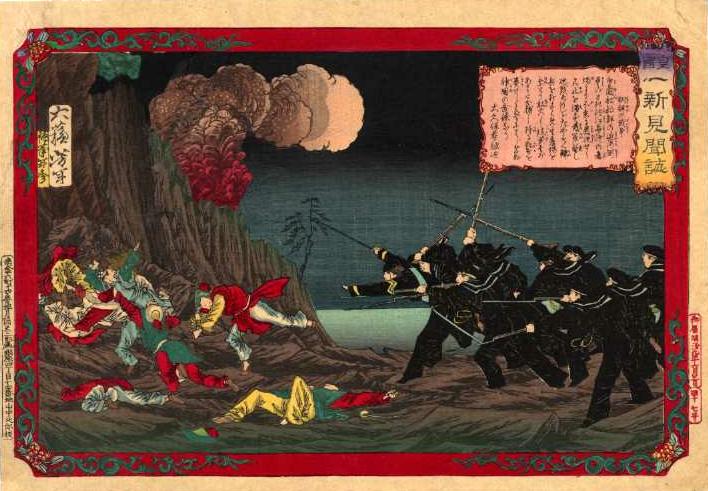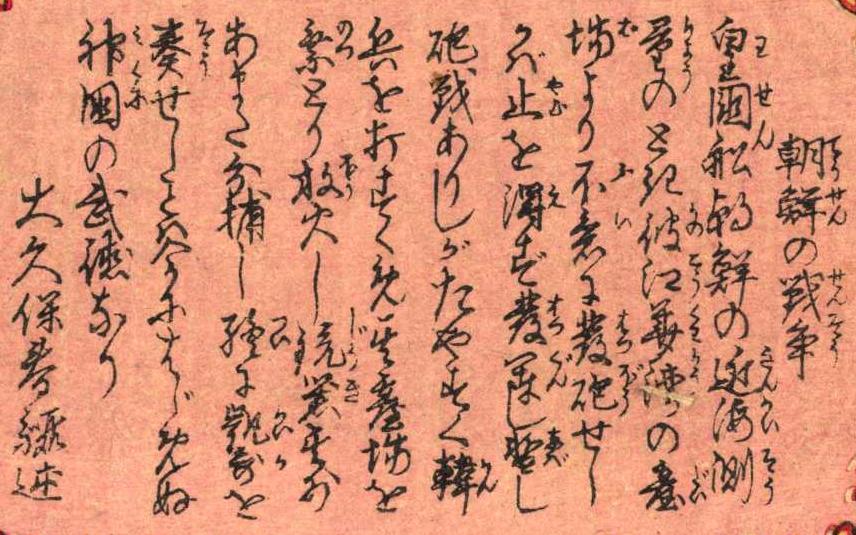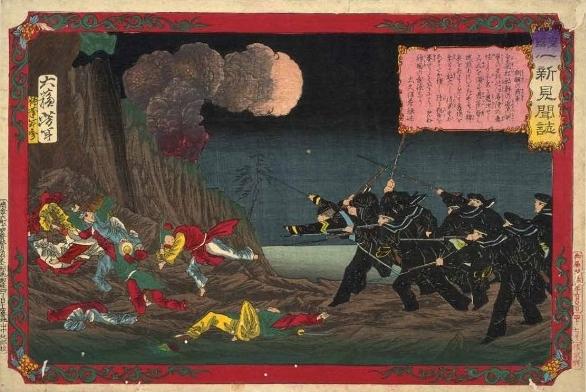|
Imperial renewal observations journal Battle in Chosen Kanghwa incident This is the last known print in a series called Kōkoku isshin kenbun shi (KIKS) on Japan's rise as an imperial state from 1853 to 1876. It shows a skirmish between Japanese and Korean soldiers on an island in Korea in September 1875. The two countries resolved the incident in February the following year with a treaty recognizing Korea as an independent state while opening some ports to Japan. |

|

|
Yosha Bunko copy without price
Series title: Kokoku isshin kenbun shi |
Transcription and translation
The story in the pink cartouche is attributed to Ōkubo Harutsugu (��v�ۏt�). I am not at all confident about the last graph of his name.
The story transcribes and translates as follows. The transcription and structural translation are mine. I have shown phonetic furigana in (small parentheses) following kanji, uncertain script in�yheavy brackets�zand unread script as ��. Hentaigana are shown in standard kana representing the orthography used on the print.
|
���N(�Ă�����)�̐푈(����) �c���t(�킹��)���N�̋ߊC(����͂�)����(������傤)�̂Ƃ���(����)�]�ؘp(����������)�̑��(������)���s��(�ӂ�)�ɔ��C�������Ύ~(���)��(��)�����R���b(���o)���C�킠�肵�����₷����(����)����ł���������������(�̂�)�Ƃ��(�ق�)���e��(������)���������������߂��I(��)�Ɂ����y�������z��t(����)�����ƃn�y���z�Ɂ������ʌ䚠(�݂���)�̈����Ȃ� ��v�ۏt�y㋁z�q |
War [battle] in Teusen [Chōsen] At the time of a near-sea survey of [survey of seas near] Chosen, [by] [graphically] a ship of the emperor's country ship ([phonetically] a Japanese ship), because suddenly [someone] sent [fired] artillery [at the ship] from a battery [on an island] in its [Chosen's] Kōkwa bay -- unavoidably [the Japanese ship] sent forces, [and] briefly there was an artillery fight, but [the Japanese forces] readily whipped the Korean soldiers ������ and [mounted and] took the battery and set fire to [it], and ������������ and seized [took as booty] the guns [small arms] -- that in the end [already] [Japan and Chosen] have concluded ����,�ynow�zthis is the influence [authority] and virtue [moral character] of [the] ������ glorious [imperial] country. Ōkubo Haru�ytsugu�z(narration) |
Commentary
The picture shows a sailors striking a beach and scattering the soldiers defending it, while fiery smoke billows from the top of the cliff. The story in the cartouche is a minimal and subjective account from the viewpoint of the victors.
Other accounts of the incident reveal that the battle took place on Kanghwa island (�]�ؓ�) in Kanghwa bay (�]�ؘp) at the mouth of the Han river (���]). Directly up the Han river was Korea's capital, Hansŏ (����), also known as Hanyang (���z) and Seoul, later as Keijō (����) and Seoul, and now only as Seoul.
Kanghwa island, as part of the larger estuary of the Han river, figured in conflicts between foreign ships and foreigners and Koreans charged with defending the area from foreign intercourse. The island had been the site of military confrontations between France and Korea in 1866 and America and Korea in 1871.
The sailors were from the Japanese naval vessel Un'yō (�_�g��). Some accounts claim the Koreans had fired on the Un'yō when it launched a boat to obtain water. The Un'yō then fired on the battery and landed a force to pacify the Koreans. Other accounts claim that the Un'yō was in Korean waters without permission, had no business conducting a survey of Korea's coasts, and had otherwise provoked the incident.
The incident took place on or about 20 September 1875. By 3 June 1876, the notification date on this print, the incident was nearly nine months old -- and the ink on the treaty the two countries signed on 26 February 1876, resolving the incident, has had three months to dry.
The 1876 treaty is considered the first to have "opened" Korea to other than Chinese intercourse in the late 19th century, much as Japan had been "opened" by the treaty it had signed with the United States in 1854, over two decades earlier. The treaties were different in nature, but both were foots in national doors that were destined to open ever wider.
For more about the Kanghwa incident and the treaty, and about Korea's names at the time, see Korea becomes Chosen in "The Empires of Japan" feature of the Yosha Research site.
Battle in Chosen
The title of the story is ���N(�Ă�����)�̐푈(����)or "Teōsen no sensō" -- meaning "Battle in Chosen". The semantic range of "sensō" (�푈) includes war, battle, fight, and skirmish.
The name of Korea at the time was ���N -- read �Ă����� (Teusen > Chōsen) in contemporary standard kana orthography -- though ���傤���� (Chiyousen > Chousen > Chōsen), the standard today, was already in some currency. Other readings included ���₤���� (Chiyausen > Chyausen > Chōsen).
The contemporary hangul version of ���N was 죠션 (Chyosyŏn), which much later became 조선 (Chosŏn).
The name of Korea in English versions of both the 1876 treaty with Japan and the 1882 treaty with the United States was "Chosen".
ship of emperor's country (Japanese ship)
The graphs �c���t (Kōkoku sen), meaning "Imperial country ship", are glossed as �킹�� (Wasen) -- which, if graphed, would have been �a�t or �a�D, meaning "Japanese ship". "Koōkoku" (�c��) is the first word of the series title.
Korean soldiers
The story refers to the soldiers of Chosen as �ؕ� (Kanhei) or "Korean soldiers" -- �� being another (though then unofficial) name for the country.
Kōkwa bay
The standard Sino-Japanese orthography for �]�� is now ������ (Kōka). At the time it was �������� (Kōkuwa > Kōkwa) -- the "kwa" being a w-glide that continued to be distinguished in orthography after it had begun to disappear from speech. Today the w-glide is rarely heard and is seen mostly in older printed matter. It survives in a number of proper nouns, though, and is otherwise more than just a linguistic curiosity.
The McCune-Reischauer romanization of the Sino-Korean name of the bay and the island, and the name by which the 1876 treaty is known, is "Kanghwa".
For more about the w-glide, see Kwannon or Kannon? in the "Language" section of the Yosha Research site.
battery
Apparently Kanghwa island was fortified with cannon batteries built during the 17th century.
In Japan, too, batteries had been built at strategic points in bays and estuaries to protect them from enemy ships. Remains of one of several gun platforms or "daiba" (���), designed by Egawa Hidetatsu and built in Edo bay in the late Tokugawa period, have been preserved in the "Odaiba" (�����) area along the waterfront of present-day Shinagawa ward in Tokyo.
For more about Egawa's accomplishments, see Egawa Tarozaemon on this website.
influence and virtue
The term �Г� (itoku) expresses the essence of the "imperial way" (�c��) in terms of the source of the emperor's benevolent authority, his power to compel followership through his exemplary leadership and compassion. �� (i) embraces the dignity or majesty (�Ќ� igen) which causes people to feel awe and submit (�ؕ� ifuku), while �� (toku) refers to the virtues that inspire devotion (Kōjien, 5th edition).
Kang Duksang's descriptionKang Duksang shows the "Battle in Chosen" print in his book on Korea and China in late Edo and Meiji period nishikie. The image of the print in his book is like the copy in Yosha Bunko in that it lacks a price, but is bluish where the Yosha Bunko and NDL copies are green -- possibly because the yellow component of an originally green pigment has faded through exposure to light. More interesting, though, is Kang's caption to the print (Kang 2007, page 32, figure 36, underscoring mine, ellipses in original).
Apparently Kang, or one of his editors, had taken the writer of the story -- #&332;kubo Harutsugu (tentative) -- to be the Ōkubo Toshimichi -- though I can find no link between these names. The background of the Kanghwa incident does, however, involve Ōkubo Toshimichi (��v�ۗ��� 1830-1878), one of most important leaders in the overthrow of the Tokugawa government and establishing of the Meiji government. Toshimichi, a former Satsuma samurai, was assassinated after the Seinan War of 1877, in which he led the government army against his former Satsuma comrade Saigō Takamori (1828-1877). In 1873, Saigo and some other leaders had pushed the government to militarily chastise Korea for incidents alleged to have been anti-Japanese. Saigo and a few others even advocated that Japan take over Korea as a means of safeguarding its regional interests. Okubo had been among the opposers. In the Kanghwa incident of September 1875, batteries on Kanghwa island, in Kanghwa bay, had fired on a Japanese naval vessel. Some historians believe the vessel was intentionally placed in harm's way in order to provoke an incident that Japan could use as a pretext for forcing Korea to open its ports to Japanese vessels and commerce -- just as some twenty years earlier, the United States had forced Japan to accommodate, first (in 1854) the needs of its ships and shipwrecked "people" (as Fillmore's letter states), then (in 1858) its diplomatic and commercial interests. Engineered or not, the outcome of the Kanghwa incident was a treaty of amity, signed by Japan and "Chosen" (as the English version of the treaty states) on 26 February 1876, in which Chosen agreed to open three treaty ports to Japan and otherwise accommodate Japan's demands for normal relations with Korea as in independent and equal state. Okubo Toshimichi and the Kanghwa treatyCynics today easily impart ulterior motives to Japan's presence in Kanghwa bay in 1875. More remarkable, though, is the manner in which Okubo Toshimichi, then Japan's Home Minister, and some other leaders again succeeded in stemming demands for military action against Korea. This time, too, the demands came mostly from quarters in Satsuma, recently blooded in the 1874 punitive expedition to Taiwan. Again, though, it made more sense to leaders like Okubo, with cooler, more strategic heads, to focus on domestic development while solving international disputes diplomatically. Note that proposals for actions against local Taiwanese tribes for killing shipwrecked Ryukyuans in 1871 were also highly controversial. The punitive expedition, mounted in the spring of 1874 from Kyushu by Saigo Tsugumichi, Takamori's younger brother, does not seem to have had the government's sanction. Once underway, of course, it had to be recognized as an action taken under Japan's flag. By the time of the Kanghwa incident in September 1875, the character of regional tensions had somewhat changed. Japan had made peace with China over Taiwan in a treaty signed in Peiking in October 1874 and withdrawn its troops from the island by the end of the year. And in May 1875, at St. Petersburg, Japan and Russia had signed a treaty which settled -- perhaps more favorably for Russia than Japan -- their long dispute over Karafuto. In any event, Japan was in no better position, in the fall of 1875, to risk any action that might draw it into a war with China, Russia, and other states with regional interests, which conceivably might come to Korea's aid. Japan was quickly learning the art of turning conflict with its neighbors into advantageous treaties.
|
Print particulars
The Battle in Chosen print is Number 47 in the Kokoku isshin kenbun shi (KIKS) series, which featured stories about events that took place between 1853 and 1876, when the series began to be published. Only twelve prints from the series are known and most are not numbered.
The print has the following signatures and publishing particulars, most of which are shared by other prints in the series.
Drawer signatures
Taisō Yoshitoshi (��h�F�N)
Assisted by (��M hohitsu) Toshimitsu (�N�Q)
Toshimitsu, both a student and an employee of Yoshitoshi (Tsukioka Yonejirō), assisted in the drawing of most of the known prints in the series.
Drawer and publisher disclosures
The names and addresses of the person taking responsibility for the drawing and the publisher are shown in two black boxes in the left margin.
����Z���\�l�Ԓn�����Ď��Y��
Minami Kinrokuchō Jūyon-banchi Tsukioka Yonejirō ga
[ Drawn by Tsukioka Yonejirō of Minami Kinrokucho 14-banchi ]
����l���ڏ\�l�Ԓn�R���k�N��
Ginza yon-chōme J\ūyon-banchi Yamanaka Kitarō han
[ Published by Yamanaka Kitarō of Ginza 4-chome 14-banchi ]
These were fairly new addresses as the time. Both became parts of Kyobashi-ku in 1878 and Chuo-ku in 1947. Minami Kinrokucho is in present-day Ginza 8-chome of Chuo-ku.
Notification date, print number, and priceThe right margin on the Yosha Bunko copy (image at top) has two red boxes showing the date of official notification and the number of the print as part of the series. ��͖�����N�Z���O�� �l�\���� A copy in the National Diet Library (image to right) has a third box stating "Price 2 sen" (�J��K Atai [Ka] ni-sen). The priced copy is probably from an older print run.
|
